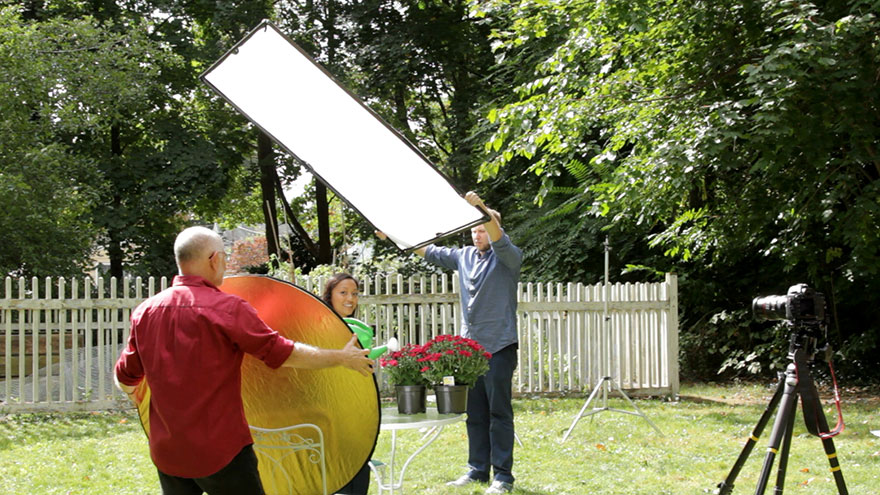Video

The Importance of Lighting for Video.
A few days ago our very first online course at Lynda.com went live. As is always the case, when we look back at a finished project we find little things here and there that we could have improved or done differently—but I am very proud with what we have here.
This project has been an unbelievable learning experience and an important professional milestone for us. This is also a very meaningful moment for me on a personal level as I have been an avid fan and user of Lynda.com for more than twelve years. I can’t even begin to tell you how much I have learned from the videos on this website. Even with topics that I’m very comfortable with, like Adobe Lightroom, I usually find a new trick, a different approach to teach or present a certain technique, or even ideas on how to organize my own educational content.
Many people don’t know that Lynda.com was founded in 1995 by husband and wife team Lynda Weinman and Bruce Heavin. They made a $20,000 investment from their personal savings and drew upon their experiences teaching computer graphics, animation, interactive design, and motion graphics.
After almost two decades of hard—and smart—work, the company has blossomed into a virtual video library with more than one million paying members, more than 2,200 courses (100,000+ individual videos), and 450 full-time employees.
Who are the authors of all these wonderful videos? The courses are created by “200 carefully selected industry experts, working professionals, and veteran teachers who are the best in their field, passionate about their subject matter, and know how to teach.” Being invited to join this elite group is, and will always be, one of the most humbling experiences of my life.
Another fascinating fact about Lynda.com is that more than half of the Fortune 100 companies, six out of the top 10 advertising agencies, 16 of the top 20 media companies, 40% of all U.S. colleges and universities, 31 state governments, and all branches of the U.S. military are active members. Surprised? I was too, but we shouldn’t be once you consider the amount and quality of the content being offered, that an average of 24 new courses are added per month, and that the entire library can be accessed for a tiny investment of $25.
Right now it’s got to be pretty obvious how much I admire this company! Now, let’s briefly talk about our course.
It is entitled “Lighting Design for Video Productions” and includes topics such as:
- Understanding the role of lighting
- Lighting interior and exterior scenes
- Directing the viewer’s attention
- Enhancing mood in a scene
- Achieving great light under harsh conditions
- Deciding on the right lighting style for your story
I believe the market is flooded with “how to” videos: how to set up a light, where to put it, which button to push, etc. All this is very important. But I believe that what most photographers transitioning into filmmaking and beginning filmmakers need most is the “why.” Why do you need to add a light here or there? Why would you use a portable disc reflector at noon? Why is it that practical lights can be so incredibly…practical?
Here’s the thing—we can make a film without sound, without color, and without a single camera movement, but we can never make a film without light. As visual storytellers, light is our color palette. With it we create mood, modify shapes, highlight texture, enhance or exaggerate our subject’s physical features, direct the viewer’s attention to relevant details or objects, and establish a time of day or a sense of space. By simply using slightly different lighting approaches you can greatly enhance your video productions.
And that’s exactly what this course is about.
We edited “Lighting Design for Video Productions” down to 46 minutes. Why? Because that’s the perfect length to watch something during lunch time or during your daily commute (assuming you are not driving!).
Wanna take a peak? Here’s the direct link. I appreciate each and every one of you for taking the time to read this, and if you have an extra second, I would love to hear what you think about it.
UPDATE: May readers and Lynda.com subscribers have been asking about the equipment we used on our Lighting course on Lynda.com. Here are the answers:
We used a variety of lights, but the main ones were Bowens Limelite Mosaic 30x30cm Daylight LED Panel.
As our A Camera we used a Canon EOS C100 Cinema EOS shooting to an Atomos Ninja-2 recorder. As our B and C Cameras we used a couple of Canon EOS 5D Mark III. We used a variety of lenses, but the main one was the Canon EF 70-200mm f/2.8L IS II USM.